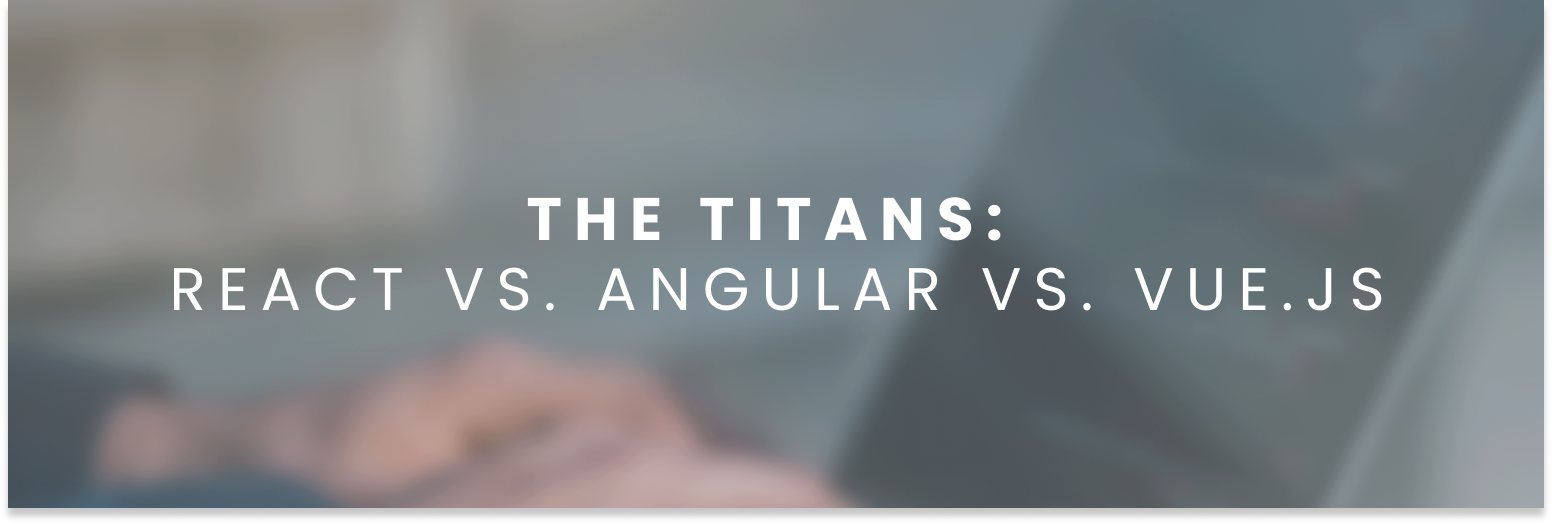Best 3 Frontend Frameworks: React, Angular and Vue.js
Frontend frameworks are key elements that you need to know, use and understand to become a top-notch developer. But first, there are some key aspects you need to take into account.
React
React is an open-source JavaScript library for building UI. Developed by Facebook, it focuses on creating dynamic and interactive web apps through a component-based architecture.
React uses a Virtual DOM to efficiently update the actual DOM, enhancing performance. Its declarative nature allows developers to describe how the UI should look based on changes in data.
Angular
It’s also part of these comprehensive frontend frameworks, but developed and maintained by Google. It empowers developers to build robust, SPAs using TypeScript, a superset of JavaScript.
Angular provides a structured framework for creating dynamic views, managing data binding, handling routing, and more.
It uses a modular architecture with components and services to encourage reusable and maintainable code, while its two-way data binding simplifies synchronizing data between the model and the view.
Vue.js
It’s a progressive JavaScript framework designed for building UI. It combines the best aspects of reactive data binding and component-based architecture.
Vue.js is lightweight and easy to integrate into existing projects. It offers a flexible and intuitive structure, allowing developers to gradually adopt its features as needed.
Vue.js simplifies building interactive UIs by providing a clear and approachable syntax, making it an excellent choice for both beginners and experienced developers.
Which Reigns Supreme?
There’s no doubt that in Effectus Software, React is of the the reigning frontend frameworks. Albeit, all of them can be used, there’s an intentional leverage on using them.
Why does it reign?
We’ll explore these aspects, but at a glance… main reasons why we love React:
React’s component reusability, efficient Virtual DOM for better performance, a large and active community, compatibility with React Native for cross-platform mobile apps, flexibility for gradual adoption.
We can add, intuitive JSX syntax and declarative approach, state management options like Redux, a rich ecosystem and tooling make it a compelling choice for many projects.
Deep Dive into Frontend Frameworks
Even though the previously mentioned are the top frontend frameworks, there’re other that could work for you. Nevertheless, we’ll get into the nitty-gritty of our top 3.
The 3 of them are frontend javascript frameworks: React, Angular, and Vue.js are all popular frontend frameworks that share several aspects despite their differences:
- Component-Based Architecture: promote a component-based architecture, allowing developers to create reusable and encapsulated UI components for building complex user interfaces.
- Reactivity and Data Binding: Reactivity is a key feature in all three frameworks, enabling automatic updates of the UI when underlying data changes.
- Single-Page Application: well-suited for building SPAs, where content is dynamically loaded and updated without full page reloads.
- Developer Tools: Each framework provides developer tools that aid in debugging, inspecting components, and understanding app behavior during development.
- Community and Ecosystem: communities and extensive ecosystems of libraries, packages, and resources that enhance development efficiency and address needs.
- Routing solutions to manage navigation within SPAs, allowing users to move between different views without full page reloads.
- Testing Support: tools and patterns for testing components and application logic, facilitating the creation of robust and maintainable code.
- State Management: while the specifics differ, they offer solutions for managing app state, ensuring consistent and predictable data flow within the UI.
- Server-Side Rendering: it can improve initial load times, enhance SEO, and provide a better user experience.
- Community Learning Resources: extensive documentation, tutorials, and online resources that help developers learn and master the technologies.
- Internationalization and Localization: support for internationalization [i18n] and localization [l10n] to create apps that cater to everyone.
While there are similarities, it’s important to note that each framework also has its own unique features, syntax, and design philosophies that differentiate them.
|
Aspect |
React | Angular |
Vue.js |
PROS |
|||
| Component Reusability | ✔️ High modularity and reusability | ✔️ Modular architecture and reusability | ✔️ Encourages component-based approach |
| Performance | ✔️ Efficient Virtual DOM for updates | ✔️ Powerful change detection mechanism | ✔️ Efficient reactivity system |
| Community Support | ✔️ Large and active community | ✔️ Strong Google support | ✔️ Growing and supportive community |
| Mobile Development | ✔️ React native enables cross-platform mobile apps | ❌ Not directly applicable | ❌ Not directly applicable |
| Flexibility | ✔️ Gradual adoption and integration | ✔️ Full-featured framework | ✔️ Can be incrementally adopted |
| JSX and Declarativity | ✔️ Intuitive JSX syntax | ❌ Angular template syntax | ✔️ Simple and intuitive template syntax |
| State Management | ✔️ Works well with Redux, MobX, etc. | ✔️ Built-in state management (RxJS) | ✔️ Options like Vuex for state |
| Ecosystem and Tooling | ✔️ Wide range of libraries and tools | ✔️ Robust development environment | ✔️ Growing ecosystem and tooling |
CONS |
|||
| Learning Curve | ❌ JSX and concepts can be complex | ❌ Steeper learning curve | ❌ May be less suitable for large apps |
| Verbosity | ❌ JSX can lead to more verbose code | ❌ Boilerplate code in some cases | ❌ Less verbose than Angular, React |
| Size | ❌ Can lead to larger bundle sizes | ❌ Bigger bundle sizes | ❌ Can lead to larger bundle sizes |
| Opinionated Approach | ❌ Less opinionated on architecture | ✔️ Strong opinions on architecture | ❌ Opinionated but less than Angular |
| Two-Way Data Binding | ❌ No built-in two-way binding | ✔️ Supports two-way data binding | ❌ Supports two-way binding |
| Learning Curve (RxJS) | ❌ Additional learning curve for RxJS | ✔️ Learning RxJS for complex apps | ❌ No built-in complex reactive system |
| Development Trend | ✔️ Still highly popular and evolving | ❌ Trend may be declining | ✔️ Trending upward in popularity |
You can also find a comparative blog between react.js and angular here, it was a click-bait post!
A Comprehensive Analysis of React, Angular, and Vue.js
A holistic approach to this will requiere a frontend and backend frameworks’ synergy analysis; full-stack is the real thing. But, we’re going to unpack these titans.
Let’s follow these criteria:
1. Popularity and Community Support:
- React: Highly popular, with a large and active community. Abundant resources, libraries, and tools are available.
- Angular: Established and backed by Google. Strong community support, though less popular compared to React.
- Vue.js: Rapidly growing in popularity, with an active and supportive community. Offers a balanced ecosystem.
2. Learning Curve:
- React: Relatively moderate learning curve, especially for those familiar with JavaScript and JSX.
- Angular: Steeper learning curve due to its opinionated architecture, TypeScript usage, and comprehensive features.
- Vue.js: Gentle learning curve, suitable for beginners. Clear documentation and simple syntax aid in quick adoption.
3. Architecture and Design:
- React: Component-based architecture using JSX. Offers flexibility and encourages modular design.
- Angular: Full-fledged framework with strong opinions on architecture. Utilizes TypeScript and features modules, components, and services.
- Vue.js: Component-based architecture similar to React, with Vue Single File Components (SFCs) providing a clear structure.
4. Data Binding and Reactivity:
- React: Uses a one-way data flow and Virtual DOM for efficient updates.
- Angular: Employs two-way data binding and a powerful change detection mechanism.
- Vue.js: Utilizes a reactive system to efficiently update the UI based on data changes.
5. State Management:
- React: Offers state management through libraries like Redux, MobX, or built-in Context API.
- Angular: Provides built-in state management with RxJS for reactive programming.
- Vue.js: Offers Vuex, a dedicated state management solution inspired by Redux, simplifying global state management.
6. Performance:
- React: Optimizes performance through the Virtual DOM, enabling efficient rendering and updates.
- Angular: Performs well with its change detection mechanism but may require additional optimization for complex applications.
- Vue.js: Offers efficient reactivity and rendering, competitive with React and Angular.
7. Tooling and Ecosystem:
- React: Offers a rich ecosystem of libraries, tools (like Create React App), and extensions (like React Router).
- Angular: Comprehensive tooling with Angular CLI, along with a wide range of built-in features and official packages.
- Vue.js: Features Vue CLI, Vue Router, and VueX for state management, alongside a growing ecosystem.
8. Flexibility and Integration:
- React: Highly flexible, allowing integration into existing projects or adoption of specific parts.
- Angular: More opinionated but provides an end-to-end solution, suitable for large applications.
- Vue.js: Offers a balanced approach, allowing incremental adoption and integration.
9. Server-Side Rendering (SSR):
- React: Supports SSR through libraries like Next.js.
- Angular: Supports SSR with Angular Universal.
- Vue.js: Supports SSR out of the box using Vue Server Renderer.
10. Mobile Development:
- React: Offers React Native for building cross-platform mobile apps using React concepts.
- Angular: Supports mobile development through Ionic framework and NativeScript integration.
- Vue.js: Can be used with NativeScript for mobile app development.
11. Future Trends:
- React: Continues to be popular and evolve, maintaining its strong position.
- Angular: Steadily evolving, with Google’s backing ensuring long-term support.
- Vue.js: Gaining popularity rapidly and likely to continue growing.
As we always say, the choice between them relies on project requirements, team expertise, and long-term goals. Each framework has its strengths and weaknesses.
A Guide to Selecting Between Frontend Frameworks help
- Project Requirements
- Rendering Needs
- SEO Considerations
- Performance Metrics
- Page Interactivity
- Data Fetching
- Development Complexity
- Full-Stack Requirements
- Community and Ecosystem
- Team Familiarity
- Scalability and Future Growth
- Budget and Timeline
- Client Requirements
Want to hire the best react devs?
A Glimpse Into Reacts’ Potential
Last updates on React 18 are a must-know for reaching top-notch development. Here you’ll find the latest. But anyways, let’s sneak a peak:
New features and improvements
Concurrent Mode, especially for complex and computationally intensive apps. You can work on multiple tasks simultaneously, dissecting them into smaller units of work.
This new features allow apps to remain responsive even when performing calculations, network requests, or rendering large component.
Let’s see this new mode in action based on several examples:
- An example of using the new
useTransitionhook to show a loading state during a slow rendering process
import { useTransition } from 'react';
const ReactComponent = () => {
const [isPending, startTransition] = useTransition();
const handleClick = () => {
startTransition(() => {
// Perform some slow operation (calculations or rendering or data fetching)
});
};
return (
<div>
{isPending ? 'Loading...' : null}
<button onClick={handleClick}>Start Process</button>
</div>
);
}- Enabling Concurrent Mode rendering.
import { unstable_createRoot } from 'react-dom';
const App = () => {
// ...
};
const rootElement = document.getElementById('root');
unstable_createRoot(rootElement).render(<App />);- Let’s explore something more challenging as betterprogramming.pub proposes:
We will use React’s Concurrent Mode with ChatGPT’S basic API.
Let’s ensure we use React app set up with Concurrent Mode enabled. You’ll need React version 18 or above. Here’s a basic structure of the application:
// App.js
import React from 'react';
import ChatContainer from './ChatContainer';
const App = () => {
return (
<div className="App">
<ChatContainer />
</div>
);
}
export default App;// ChatContainer.js
import React, { useState, useEffect, Suspense } from 'react';
import { createChatGPTSession, generateChatGPTResponse } from './api'; // Assume you have an API module for interacting with ChatGPT
const ChatConversation = React.lazy(() => import('./ChatConversation'));
const ChatInput = React.lazy(() => import('./ChatInput'));
const ChatContainer = () => {
const [conversation, setConversation] = useState([]);
useEffect(() => {
// Initialize the ChatGPT session
const session = createChatGPTSession();
// Store the session for future use or clean up
return () => {
// Clean up the session
// Close or release any resources related to the ChatGPT session
};
}, []);
const handleUserMessage = async (message) => {
// Add the user's message to the conversation
setConversation((prevConversation) => [...prevConversation, { author: 'user', message }]);
// Generate a response from ChatGPT
const response = await generateChatGPTResponse(session, message);
// Assume the generateChatGPTResponse function sends a request to your API to get the response from ChatGPT
// Add the ChatGPT's response to the conversation
setConversation((prevConversation) => [...prevConversation, { author: 'chatbot', message: response }]);
};
return (
<div className="ChatContainer">
<h1>Chat with ChatGPT</h1>
<Suspense fallback={<div>Loading...</div>}>
<ChatConversation conversation={conversation} />
<ChatInput onMessage={handleUserMessage} />
</Suspense>
</div>
);
}
export default ChatContainer;// ChatConversation.js
import React from 'react';
const ChatConversation = ({ conversation }) => {
return (
<div className="ChatConversation">
{conversation.map((message, index) => (
<div key={index} className={`message ${message.author}`}>
{message.message}
</div>
))}
</div>
);
}
export default ChatConversation;// ChatInput.js
import React, { useState } from 'react';
const ChatInput = ({ onMessage }) => {
const [message, setMessage] = useState('');
const handleSubmit = (e) => {
e.preventDefault();
onMessage(message);
setMessage('');
};
return (
<form onSubmit={handleSubmit} className="ChatInput">
<input
type="text"
placeholder="Type your message..."
value={message}
onChange={(e) => setMessage(e.target.value)}
/>
<button type="submit">Send</button>
</form>
);
}In this example, the
ChatContainercomponent manages the conversation state using theuseStatehook. TheuseEffecthook is used to initialize the ChatGPT session when the component mounts. ThehandleUserMessagefunction is called when the user sends a message, and it updates the conversation state with the user’s message and generates a response from ChatGPT using thegenerateChatGPTResponsefunction (which you would implement based on your backend setup).The conversation is then rendered in the
ChatConversationcomponent, and user input is captured using theChatInputcomponent. TheReact.lazyfunction is used for lazy loading these components to take advantage of Concurrent Mode’s improved performance.Remember that this is a simplified example, and you may need to modify it based on your specific requirements and the integration details of your ChatGPT API.
Taken from: Ievgenii Spitsyn
A bit of Angular
There’s a vast community behind Angular finding and developing improvements. Here’s a click-bait post for you to delve into from Cavepot’s team.
Check Angulars lighthouse to find the toolkit you’re looking for.
A bit of Vue.js
Vue.js does not have a fixed release cycle. Patch releases are released as needed.
Minor releases always contain new features, with a typical time frame of 3~6 months in between. Minor releases always go through a beta pre-release phase.
Major releases will be announced ahead of time, and will go through an early discussion phase and alpha / beta pre-release phases.
There are some easy-peasy features and tools from react that you should be already using!
React was created by Facebook and is heavily used across its products, including the main Facebook website and the Facebook mobile app.
One prominent example of React’s usage at Facebook is in the development of the News Feed, a core feature of the Facebook platform.
The News Feed displays a dynamic stream of posts, photos, and updates from a user’s friends and pages they follow.
React’s component-based architecture and efficient rendering make it well-suited for creating a responsive and interactive feed.
Here’s a simplified example of how React might be used in the context of building a Facebook-like News Feed:
import React, { Component } from 'react';
class NewsFeed extends Component {
constructor(props) {
super(props);
this.state = {
posts: [] // An array of post data
};
}
componentDidMount() {
// Simulate fetching posts from an API
fetch('https://api.example.com/posts')
.then(response => response.json())
.then(posts => {
this.setState({ posts });
});
}
render() {
const { posts } = this.state;
return (
<div className="news-feed">
{posts.map(post => (
<div className="post" key={post.id}>
<h2>{post.title}</h2>
<p>{post.content}</p>
{/* Other post details */}
</div>
))}
</div>
);
}
}
export default NewsFeed;In this example, the NewsFeed component fetches a list of posts from an API and renders them as individual post components using React’s JSX syntax.
Each post is represented as a separate component, making it easy to manage and update the UI when new posts are fetched or when the user interacts with the feed.
Just remember this is a simple example.
Instagram:
Instagram, also owned by Facebook, uses React extensively for its web application. Let’s see the photo feed:
import React, { Component } from 'react';
class PhotoFeed extends Component {
constructor(props) {
super(props);
this.state = {
photos: [] // An array of photo data
};
}
componentDidMount() {
// Simulate fetching photos from an API
fetch('https://api.example.com/photos')
.then(response => response.json())
.then(photos => {
this.setState({ photos });
});
}
render() {
const { photos } = this.state;
return (
<div className="photo-feed">
{photos.map(photo => (
<div className="photo" key={photo.id}>
<img src={photo.url} alt={photo.caption} />
<p>{photo.caption}</p>
{/* Other photo details */}
</div>
))}
</div>
);
}
}
export default PhotoFeed;WhatsApp Web:
WhatsApp’s web version uses React for building its user interface.
We can provide you with a simplified example of how a feature might be implemented using React. A hypothetical feature where a user can send messages in a chat interface.
In this example, we’ll create a simple chat component using React. This is, of course, a simplified representation and does not represent the exact code used by WhatsApp Web.
// ChatMessage.js
import React from 'react';
const ChatMessage = ({ message }) => {
return (
<div className="chat-message">
<p>{message.text}</p>
<span className="timestamp">{message.timestamp}</span>
</div>
);
};
export default ChatMessage;
// ChatInput.js
import React, { useState } from 'react';
const ChatInput = ({ onSendMessage }) => {
const [inputText, setInputText] = useState('');
const handleInputChange = (event) => {
setInputText(event.target.value);
};
const handleSendClick = () => {
if (inputText.trim() !== '') {
onSendMessage(inputText);
setInputText('');
}
};
return (
<div className="chat-input">
<input
type="text"
value={inputText}
onChange={handleInputChange}
placeholder="Type your message..."
/>
<button onClick={handleSendClick}>Send</button>
</div>
);
};
export default ChatInput;
// ChatApp.js
import React, { useState } from 'react';
import ChatMessage from './ChatMessage';
import ChatInput from './ChatInput';
const ChatApp = () => {
const [messages, setMessages] = useState([]);
const handleSendMessage = (text) => {
const newMessage = {
text,
timestamp: new Date().toLocaleTimeString(),
};
setMessages([...messages, newMessage]);
};
return (
<div className="chat-app">
<div className="chat-container">
{messages.map((message, index) => (
<ChatMessage key={index} message={message} />
))}
</div>
<ChatInput onSendMessage={handleSendMessage} />
</div>
);
};
export default ChatApp;In this example, we’ve created three React components: ChatMessage, ChatInput, and ChatApp. The ChatMessage component displays a single message with a timestamp.
The ChatInput component allows the user to type and send messages. The ChatApp component manages the state of messages and renders both the message container and the input component.
Uber:
React is used in various parts of Uber’s web applications to enhance user interaction and dynamic content.
// RideOptions.js
import React from 'react';
const RideOptions = ({ options, onSelectRide }) => {
return (
<div className="ride-options">
<h2>Choose a ride:</h2>
<ul>
{options.map((option, index) => (
<li key={index}>
<button onClick={() => onSelectRide(option)}>{option.name}</button>
</li>
))}
</ul>
</div>
);
};
export default RideOptions;
// RideBooking.js
import React, { useState } from 'react';
import RideOptions from './RideOptions';
const RideBooking = () => {
const [selectedRide, setSelectedRide] = useState(null);
const rideOptions = [
{ name: 'Economy', price: 10 },
{ name: 'Premium', price: 20 },
{ name: 'Luxury', price: 30 },
];
const handleSelectRide = (ride) => {
setSelectedRide(ride);
};
const handleBookRide = () => {
if (selectedRide) {
alert(`Booked ${selectedRide.name} ride for $${selectedRide.price}`);
} else {
alert('Please select a ride option.');
}
};
return (
<div className="ride-booking">
<h1>Ride Booking</h1>
<RideOptions options={rideOptions} onSelectRide={handleSelectRide} />
<button onClick={handleBookRide}>Book Ride</button>
</div>
);
};
export default RideBooking;In this simplified example, we have two React components: RideOptions and RideBooking. The RideOptions component displays a list of ride options, and the user can select one.
The RideBooking component manages the state of the selected ride and provides a button to book the chosen ride.
Tesla:
Tesla’s website uses React to showcase its electric vehicles and provide a seamless browsing experience.
Implementing a complete Tesla-like feature involves creating a highly complex system that integrates hardware, software, real-time data processing, and more.
Here, I’ll provide a very simplified example of how you might create a basic electric vehicle (EV) dashboard using React, which displays some vehicle information.
// EVStatus.js
import React from 'react';
const EVStatus = ({ batteryLevel, chargingStatus }) => {
return (
<div className="ev-status">
<h2>Electric Vehicle Status</h2>
<p>Battery Level: {batteryLevel}%</p>
<p>Charging Status: {chargingStatus ? 'Charging' : 'Not Charging'}</p>
</div>
);
};
export default EVStatus;
// TeslaDashboard.js
import React, { useState } from 'react';
import EVStatus from './EVStatus';
const TeslaDashboard = () => {
const [batteryLevel, setBatteryLevel] = useState(75);
const [chargingStatus, setChargingStatus] = useState(false);
const handleToggleCharging = () => {
setChargingStatus(!chargingStatus);
};
return (
<div className="tesla-dashboard">
<h1>Tesla Dashboard</h1>
<EVStatus batteryLevel={batteryLevel} chargingStatus={chargingStatus} />
<button onClick={handleToggleCharging}>
{chargingStatus ? 'Stop Charging' : 'Start Charging'}
</button>
</div>
);
};
export default TeslaDashboard;In this simplified example, we have two React components: EVStatus and TeslaDashboard. The EVStatus component displays the battery level and charging status of the electric vehicle.
The TeslaDashboard component manages the state of battery level and charging status and provides a button to toggle the charging status.
Remember you can always check your code by using AI! Read our blogposts!
Rounding up Frontend Frameworks!
The importance of Frontend development Frameworks lies in painstakingly and sensitively drilling down and choosing the best possible framework. Mind the team!
It’s crucial for developers and organizations to stay up-to-date with frontend frameworks and be part of a robust community of devs.
There’s a reason why Facebook, Tesla, Instagram and WhatsApp choose React!
Stay tuned, and don’t forget to check out our other posts for more insights on code improvement and tips!





Leave a Reply
You must be logged in to post a comment.